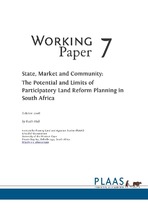| dc.description.abstract | Market-assisted land reform, as promoted by the World Bank, has made little progress in South Africa: since the advent of democracy in 1994, just 4 per cent of white-owned agricultural land has been redistributed to black South Africans. Support for new land users has been limited and uneven in its reach, and yet beneficiaries have been required to follow business plans that emulate commercial farming. As a result, much redistributed land has been under-utilised and livelihood benefits for beneficiaries themselves have been limited.
This has prompted mobilisation by landless people and their allies in favour of new policy options, which would see greater state intervention in planning, land acquisition and production support. This in turn has forced the state to confront questions on which it has, up to now, been agnostic: which land should be acquired, where, for whom and for what? These questions are to be answered through a new area-based planning approach that involves specific plans for land reform at district level. This has seen the state for the first time determining the nature, location, purpose and target group for redistribution, rather than leaving these questions to the market. However, rural people themselves have already expressed fears that state planning is consultant driven and fails to take their needs and interests into consideration.
This paper explores the limits to both state- and market-led land reform approaches, and the potential of a hybrid that is founded on participation in decision-making by rural residents themselves. It describes an initiative to pilot a participatory approach in the Breede River Winelands district of the Western Cape. Here, the dualism of the agrarian sector is starkly evident: a
high-value commercial farming sector, particularly deciduous fruit and wine, lies side-by-side with small-scale livestock and vegetable production by the poor, including evicted former farm workers. The question of who would define the plan for land reform, and how participation would be structured, is the focus of the paper. In the process, the paper explores conceptual and practical foundations for the World Bank's conception of 'community-led land reform' in which rural people as drivers of their own development are required to act as entrepreneurs in an uneven market environment. Instead, the paper presents some guiding principles to inform participatory land reform planning, in which participation involves multi-faceted processes to amplify, analyse, negotiate and hear the voices of landless people, and not the abrogation of state responsibilities. | en_US |

